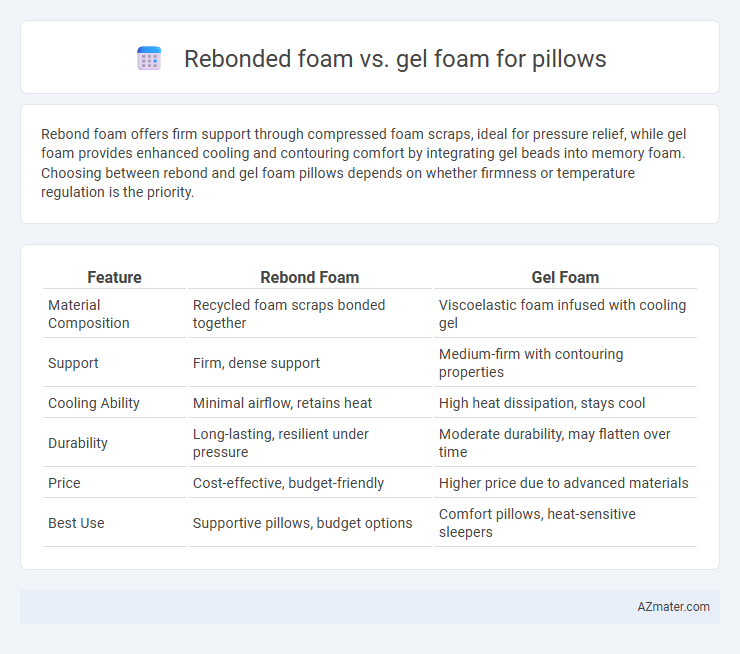Rebond foam offers firm support through compressed foam scraps, ideal for pressure relief, while gel foam provides enhanced cooling and contouring comfort by integrating gel beads into memory foam. Choosing between rebond and gel foam pillows depends on whether firmness or temperature regulation is the priority.
Table of Comparison
| Feature | Rebond Foam | Gel Foam |
|---|---|---|
| Material Composition | Recycled foam scraps bonded together | Viscoelastic foam infused with cooling gel |
| Support | Firm, dense support | Medium-firm with contouring properties |
| Cooling Ability | Minimal airflow, retains heat | High heat dissipation, stays cool |
| Durability | Long-lasting, resilient under pressure | Moderate durability, may flatten over time |
| Price | Cost-effective, budget-friendly | Higher price due to advanced materials |
| Best Use | Supportive pillows, budget options | Comfort pillows, heat-sensitive sleepers |
Overview: What is Rebond Foam and Gel Foam?
Rebond foam is made by shredding and fusing scrap polyurethane foam pieces, creating a dense, firm material known for its durability and support in pillows. Gel foam incorporates gel-infused polyurethane foam designed to provide enhanced cooling properties and pressure relief by distributing weight evenly. Both materials offer unique benefits: rebond foam emphasizes resilience and longevity, while gel foam prioritizes temperature regulation and comfort.
Key Differences Between Rebond and Gel Foam Pillows
Rebond foam pillows are made from shredded foam pieces bonded together, offering dense support and durability, while gel foam pillows incorporate cooling gel beads or layers to regulate temperature and provide pressure relief. The key differences lie in their composition and performance: rebond foam excels in firmness and longevity, whereas gel foam enhances comfort through superior heat dissipation and softness. Choosing between them depends on preferences for support level and thermal regulation during sleep.
Comfort and Support: Foam Performance in Pillows
Rebond foam offers firm support by combining shredded foam pieces, maintaining shape under pressure, ideal for those needing consistent spinal alignment. Gel foam integrates cooling gel beads that promote airflow and dissipate heat, enhancing comfort with a softer, temperature-regulating feel. Pillow choice depends on preference for firm support with durability (rebond foam) versus pressure relief and temperature control (gel foam).
Temperature Regulation: Cooling Properties Compared
Gel foam pillows offer superior temperature regulation by incorporating cooling gel particles that absorb and dissipate heat, maintaining a comfortable sleep surface throughout the night. Rebond foam, made from recycled foam scraps bonded together, tends to retain more heat and lacks the advanced cooling technology found in gel foam variants. Consumers seeking enhanced cooling properties and reduced nighttime sweating often prefer gel foam pillows for their effective moisture-wicking and thermal dispersion capabilities.
Durability and Longevity of Rebond vs Gel Foam Pillows
Rebond foam pillows demonstrate superior durability due to their dense, resilient structure that maintains shape and support over extended use compared to gel foam pillows. Gel foam pillows, while offering enhanced cooling properties, tend to soften and degrade faster under consistent pressure, reducing their lifespan. The longevity of rebond foam makes it a cost-effective choice for consumers seeking long-term pillow performance and structural integrity.
Allergen Resistance and Hygiene Factors
Rebond foam pillows exhibit moderate allergen resistance due to their dense structure that limits dust mite accumulation, while gel foam offers superior hygiene benefits with its antimicrobial properties and enhanced breathability that reduces moisture buildup. Gel foam's open-cell design minimizes bacterial growth, making it a preferred option for allergy sufferers requiring a cleaner sleeping surface. Both materials are hypoallergenic, but gel foam consistently ranks higher in maintaining long-term freshness and reducing irritant exposure.
Pricing: Cost Differences and Value for Money
Rebond foam pillows generally cost less than gel foam pillows due to the lower manufacturing expenses of recycled foam materials. Gel foam pillows, infused with cooling gel, demand a higher price point reflecting enhanced temperature regulation and comfort benefits. While rebond foam offers budget-friendly durability, gel foam provides superior pressure relief, making it a worthwhile investment for users seeking advanced sleep quality.
Best Use Cases: Who Should Choose Which Foam?
Rebond foam offers high durability and firm support, making it ideal for people who prefer a resilient pillow that maintains its shape over time, especially side and back sleepers. Gel foam provides superior cooling properties and pressure relief, suited for hot sleepers or those with neck pain seeking a softer, more contouring pillow. Choosing between rebond foam and gel foam depends on individual sleep habits, temperature preferences, and the desired level of support and comfort.
User Reviews and Customer Satisfaction
Rebond foam pillows receive praise for their firm support and durability, favored by users seeking consistent neck alignment and pressure relief during sleep. Gel foam pillows are highly rated for their enhanced cooling properties and softness, providing a comfortable sleep experience that reduces heat retention. Customer satisfaction surveys indicate a preference for gel foam in warmer climates, while rebond foam is preferred by individuals requiring robust, long-lasting support.
Final Verdict: Choosing the Right Foam Pillow for You
Rebond foam pillows provide firm support and durability, making them ideal for individuals who prefer a dense, resilient feel that maintains shape over time. Gel foam pillows offer enhanced cooling properties and better pressure relief, which benefits hot sleepers or those seeking improved comfort and contouring. Choosing the right pillow depends on your sleep preferences: select rebond foam for long-lasting support or gel foam for temperature regulation and softer cushioning.

Infographic: Rebond foam vs Gel foam for Pillow
 azmater.com
azmater.com